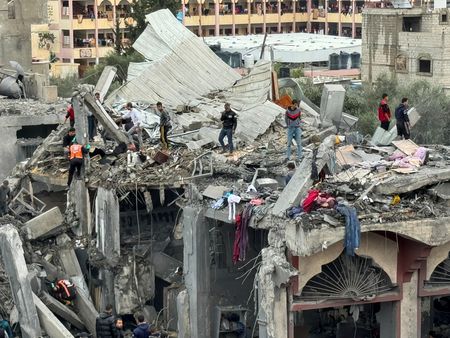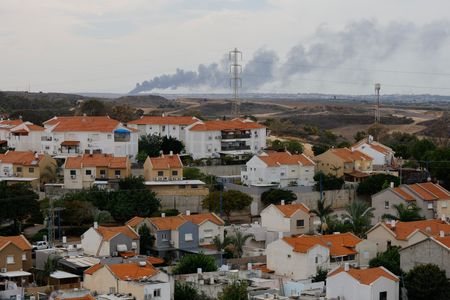(Reuters) – Israel ordered people out of swathes of Gaza’s main southern city on Monday as it pressed its ground campaign deep into the south of the enclave, sending desperate residents fleeing, after the collapse on Friday of a week-long truce.
Following is a timeline of the war between Israel and Hamas, the Palestinian Islamist movement that controls the Gaza Strip.
Oct. 7: Hamas gunmen carry out a surprise attack on southern Israel, crossing over from Gaza and rampaging through nearby communities. They kill 1,200 people, mainly civilians, and take over 240 hostages back to Gaza, according to Israeli tallies.
Hamas military commander Mohammad Deif urges Palestinians everywhere to fight.
Israeli Prime Minister Benjamin Netanyahu says Israel is “at war” and retaliatory air strikes on densely populated Gaza begin, along with a total siege of the coastal Palestinian enclave squeezed between Israel and Egypt.
Oct. 13: Israel tells residents of Gaza City, where more than 1 million of the enclave’s 2.3 million people live, to evacuate and move south. Gaza remains closed and residents say they have nowhere to go after southern parts of the Strip also come under Israeli bombardment.
Oct. 17: An explosion at al-Ahli al-Arabi Baptist hospital in Gaza City causes heavy casualties and triggers outrage in the Arab world. Palestinians blame the blast on an Israeli air strike but Israel says it was caused by a misfiring Palestinian rocket launch.
The health ministry in Gaza says 471 people were killed. Israel disputes this figure and an unclassified U.S. intelligence report estimates the death toll “at the low end of the 100-to-300 spectrum”.
Oct. 18: U.S. President Joe Biden visits the Middle East to show support for Israel and try to prevent a wider regional conflict. He ascribes the hospital blast to an errant rocket fired by Gaza militants. Arab leaders respond to the deaths at the hospital, which they blame on Israel, by cancelling a summit with Biden in Jordan.
Oct. 20: Hamas releases two American hostages – Judith Tai Raanan, 59, and her daughter Natalie, 17. The women had been taken from Nahal Oz kibbutz in southern Israel.
Oct. 21: Aid trucks are allowed through the Rafah border crossing from Egypt into Gaza after days of diplomatic wrangling. It is only a small fraction of what is required in Gaza, where food, water, medicines and fuel are running out.
Oct. 23: Hamas releases two more hostages, elderly Israelis Nurit Cooper and Yocheved Lifshitz, “on humanitarian and poor health grounds”. The two women were kidnapped from Nir Oz kibbutz with their husbands, who remain in Hamas captivity. As she is freed, Lifshitz shakes hands with one of the militants and says “shalom” (peace).
Oct. 27: Israel’s chief military spokesperson says Israeli ground forces are expanding their operations inside Gaza, signalling the start of a ground offensive.
Oct. 28: Netanyahu says Israeli forces have begun the second phase of the war and that Israel will “destroy the enemy above ground and below ground”. He tells Israelis to expect a “long and hard” military campaign.
Oct. 31: Israeli air strikes hit Gaza’s crowded Jabalia refugee camp. Israel says it has killed a Hamas commander. Palestinian health officials say the strike killed about 50 people and wounded 150.
Nov. 1: Evacuations from Gaza begin through the Rafah crossing for an estimated 7,000 foreign passport holders, dual nationals and their dependents, and people needing urgent medical treatment.
Nov. 6: U.N. Secretary General Antonio Guterres says Gaza is becoming a “graveyard for children”, and demands a ceasefire. Palestinian health authorities say the death toll from Israeli strikes has exceeded 10,000.
Nov. 13: Israeli tanks advance on Gaza City’s Al Shifa hospital, with some 650 patients still inside. Israel says the hospital sits atop tunnels housing a headquarters for Hamas fighters using patients as shields, which Hamas denies.
Nov. 15: Israeli special forces enter Al Shifa Hospital and search the site, which covers more than 20 acres, with patients still inside. They initially uncover only a small collection of weapons but in the following days find the entrance to a concrete-walled tunnel and show footage of what they say is a 55-metre (181-foot) section, 10 metres (33 feet) underground.
Nov. 21: Israel and Hamas announce agreement on a four-day pause in fighting, with a big increase in humanitarian, medical and fuel aid to be allowed into Gaza.
Palestinian health authorities say Israel’s bombardment has killed about 14,000 Gazans, roughly 40% of them children.
Dec. 1: After two last-minute extensions, talks to further lengthen the truce collapse and Israeli warplanes pound Gaza anew, sending wounded and dead Palestinians into hospitals and forcing hundreds to flee.
During the week-long truce, Hamas releases 105 of its hostages in return for 240 Palestinian detainees. But with most women, and children hostages now believed free, the truce collapsed over terms for releasing more, including Israeli men and soldiers. Israel says 136 hostages are still being held.
Dec. 2: U.S. Vice President Kamala Harris says too many innocent Palestinians have been killed in Gaza as Israeli jets and artillery continue to hammer the enclave. The Gaza health ministry says the enclave’s death toll has risen above 15,000.
(Compiled by Mark Heinrich, Editing by Angus MacSwan)


